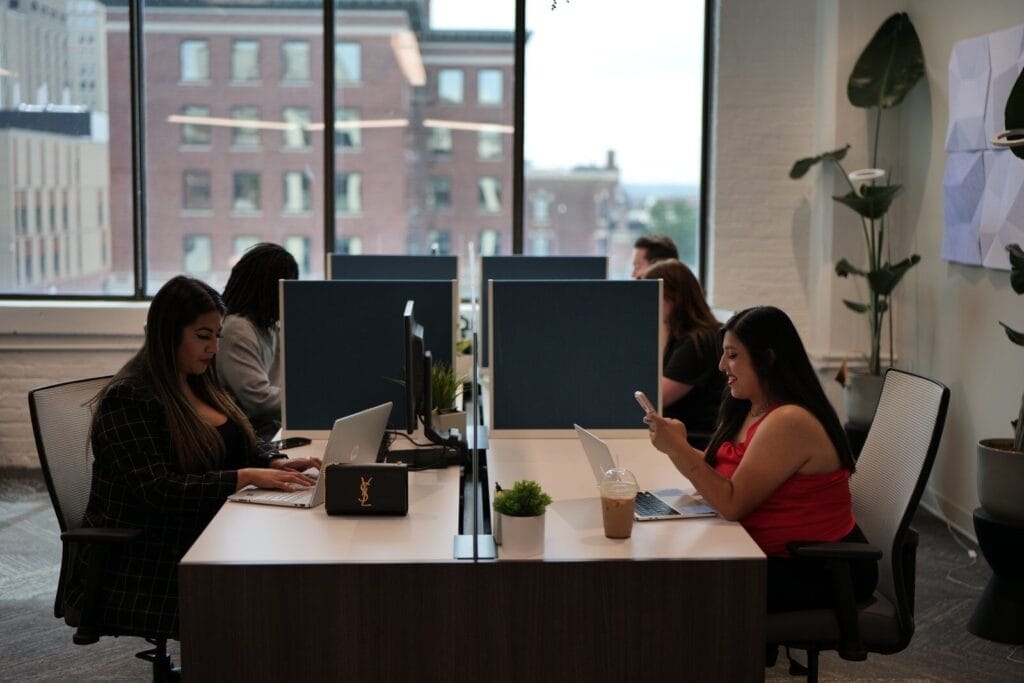The modern workplace is changing a lot, focusing on being flexible and efficient in hybrid work situations. Flexible office spaces are emerging as a leading solution, catering to the evolving demands of businesses and employees alike.
This article discusses the benefits of flexible workspaces. It explains how these workspaces are changing traditional office environments. Flex space will enhance productivity and provide cost advantages, redefining the future of work.
What are the Benefits of Flexible Office Spaces?
How do Flexible Workspaces Enhance Productivity?
Designers create flexible workspaces to foster an environment conducive to productivity. These spaces offer different layouts like open desks, collaborative areas, and private offices. Employees can pick the setting that fits their work style best.
This adaptability can significantly enhance focus and creativity, as individuals can shift between environments based on their tasks. Furthermore, flexible offices often incorporate state-of-the-art technology, which streamlines processes and improves communication. The result is a work environment where employees can thrive, ultimately leading to increased productivity across the board.
What Cost Advantages Do Flexible Offices Offer?
One of the most compelling benefits of flexible space is their cost-effectiveness. Traditional office leases often require long-term commitments, which can be a financial burden for many businesses, especially startups.
Flexible offices offer short-term leases or pay-as-you-go options. This allows companies to change their space as needed. Companies can adjust their space based on their needs.
This flexibility not only reduces overhead costs but also enables businesses to allocate resources more efficiently. Flexible workspaces have meeting rooms and fast internet. This helps save money on these important services.
How Can Flexible Workspace Improve Work-Life Balance?
Flexible office spaces provide a healthier work-life balance by accommodating various work styles and preferences. As remote work grows, flexible workspaces let employees choose to work from home or in shared spaces, based on their tasks and personal schedules. This hybrid approach allows individuals to manage their time more effectively, reducing stress and enhancing overall job satisfaction. Coworking spaces create a sense of community, offering support and networking opportunities that enhance a balanced work-life experience.

How Does Flexible Workspace Differ from Traditional Office Space?
What Key Features Set Flexible Workspaces Apart?
The key features that distinguish flexible workspaces from traditional office space include adaptability, variety, and community. Flexible workspaces let businesses design their office space to fit their specific requirements.
This is different from traditional offices, which have set layouts. Businesses can adjust the workspace to suit their needs. This flexibility is not possible in traditional offices.
Additionally, these spaces often encourage collaboration and networking, fostering a sense of community among diverse professionals. This dynamic environment not only enhances creativity but also provides opportunities for knowledge sharing and professional growth.
What Do Flexible Workspaces Offer Over a Traditional Office?
Choosing a flexible office space over a traditional office presents several advantages. Flexible lease terms help businesses adjust to market changes without tying them down with long commitments. This is particularly beneficial for startups that may experience rapid growth or shifts in focus.
Furthermore, companies typically locate flexible office spaces in prime areas, which can enhance their visibility and reputation. Modern features and teamwork in these places attract skilled workers, helping businesses create a strong team more easily.

How Does Offering Flexible Workspaces Impact Employee Satisfaction?
The office setup plays a crucial role in employee satisfaction. Flexible workspaces offer a variety of options, from quiet zones for focused work to collaborative areas for brainstorming sessions. This variety allows employees to choose the environment that best suits their needs, leading to increased comfort and engagement.
Moreover, organizations that invest in creating a positive office environment, complete with ergonomic furniture and vibrant decor, can significantly boost morale. A well-designed flexible workspace can enhance the overall employee experience, resulting in higher retention rates and improved productivity.
What Types of Flexible Offices are Available?
What are the Options for Coworking Spaces?
Coworking spaces are among the most popular options within the realm of flexible office spaces. These shared environments offer individuals and small businesses the opportunity to work alongside like-minded professionals, fostering collaboration and innovation.
Coworking spaces offer services like fast internet, meeting rooms, and shared areas. They are popular among freelancers and new businesses. Additionally, many coworking spaces organize networking events and workshops, further enhancing the sense of community and providing valuable professional development opportunities.
How Do Private Offices Fit into the Flexible Workspace Model?
Private offices are another key component of the flexible workspace model. While coworking spaces are ideal for collaboration, private offices offer a dedicated area for teams or individuals who require a more focused environment. Businesses can rent these offices for a short time, which helps them grow without committing to a long lease.
Private offices often come equipped with essential amenities, providing a professional atmosphere without sacrificing the flexibility that modern businesses need. This combination of privacy and adaptability makes private offices an appealing option for companies of all sizes.
What is the Role of Meeting Rooms in Flex Space?
Meeting rooms play a vital role in flexible office spaces, serving as dedicated areas for collaboration and brainstorming. These rooms accommodate different group sizes and people can reserve them when needed. This allows teams to meet without the limitations of a regular office.
Meeting rooms in flexible workspaces have modern technology like video conferencing and presentation tools to improve communication and teamwork. Flexible office spaces help organizations hold effective meetings, boosting productivity and collaboration in a hybrid work model by giving access to professional environments.
How Can Startups Benefit from Flexible Office Setup?
What Flexibility Do Startups Gain from Coworking Arrangements?
Startups stand to gain significant advantages from coworking arrangements, particularly regarding flexibility and resource allocation. Startups can save money by using flexible office spaces instead of traditional leases. This allows them to focus on their main business activities and take advantage of flexible space options.
Adjusting workspace size as they grow is important. This is especially true during the early stages of development. Additionally, coworking spaces often provide access to a network of fellow entrepreneurs, creating invaluable opportunities for collaboration, mentorship, and potential partnerships.
How Does a Flexible Office Space Support Growth for Startups?
A flexible office space supports growth for startups by providing the infrastructure and resources necessary for success. Flexible workspaces offer key services such as administrative help and IT support. This allows startups to focus on their business. They don’t have to worry about managing an office.
Flexible workspaces promote teamwork and idea sharing, helping startups stand out in competitive markets. A flexible office space can help startups grow and be creative, leading to long-term success.
What Are the Risks of Traditional Leases for Startups?
Traditional leases pose several risks for startups that can hinder their growth and success. Long-term commitments can lead to financial issues for startups with untested business models. This is why flexible workspaces are becoming more popular.
Having a traditional office can be costly. You have to pay for deposits and renovations. This takes money away from important areas like product development and marketing.
Traditional office leases can restrict a startup’s ability to change with the market. Traditional office leases can limit a startup’s ability to adapt to the market.
Flexible office spaces are a better option for young companies. They help these businesses succeed in a constantly changing environment.
What are the Future Trends in Flexible Workspaces?
How is Technology Shaping Flexible Office Spaces?
Technology is crucial for the future of flexible offices, making serviced spaces easier to access and more efficient. From advanced booking systems for meeting rooms to integrated communication tools that facilitate collaboration among remote teams, technology enhances the functionality of flexible workspaces.
Virtual and augmented reality will change how we experience offices, offering new and engaging design and layout possibilities. As businesses continue to embrace digital transformation, flexible office spaces will increasingly leverage technology to create more efficient and user-friendly work environments.

What Cultural Shifts are Driving the Demand for Flexible Work?
Several cultural shifts are driving the demand for flexible work environments. More people want flexibility in their jobs because of the focus on work-life balance and the increase in remote and hybrid work options.
Organizations are now designing office spaces to promote teamwork, innovation, and a sense of belonging. This shift is in response to the increasing importance placed on mental health and well-being. As the workforce changes, the need for flexible office spaces that meet different needs will keep increasing.
What Innovations Are Emerging in the Flexible Workspace Industry?
The flexible workspace industry is witnessing a wave of innovations aimed at enhancing user experience and functionality. Flexible office spaces have a bright future. They will have customizable furniture and smart technology. These features will help use resources better and create workspaces that fit different needs.
Additionally, the emergence of wellness-focused design elements, such as biophilic features and ergonomic furniture, is reshaping how we think about office environments. Businesses recognize the value of supportive work environments. As a result, flexible office spaces will continue to evolve. They aim to offer benefits that cater to the needs of today’s professionals.